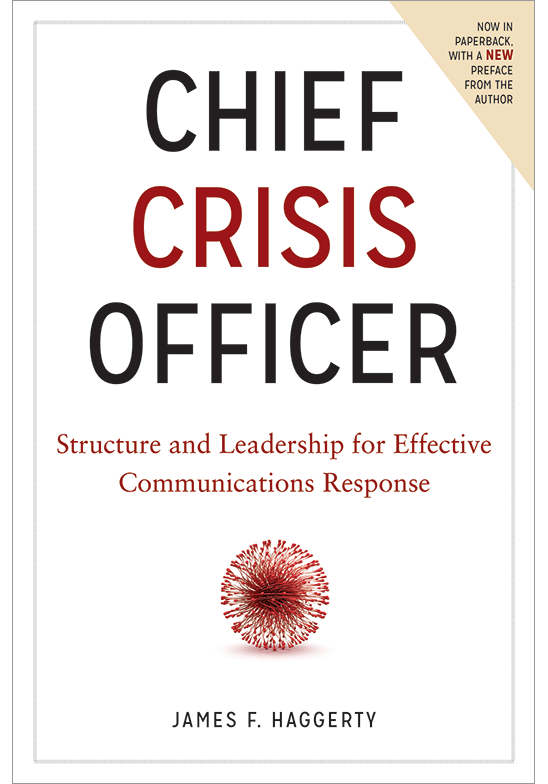‘Chief Crisis Officer’: Crisis Defined

This is an excerpt from CrisisResponsePro founder James F. Haggerty’s new book, Chief Crisis Officer: Structure and Leadership for Effective Communications Response (ABA Publishing). We will post other excerpts to the Knowledge Exchange periodically. In this section, Haggerty discusses the definition of “crisis.”
No company or organization is immune from crisis. Regardless of size or industry, whether for-profit or nonprofit, any organization that faces the public and has an interest in the way it is perceived must be prepared for the crisis events with the potential to negatively impact the reputation of the organization, and, as a result, markets, profits, or other business or organizational goals.
Sounds perfectly simple, yes? Of course. However, in practice, I think it’s fair to say that most organizations, regardless of size, are ill-prepared when a crisis hits. In this chapter and the chapters that follow, we’re going to consider why that is and what to do about it.
But let’s start at the beginning: What is a crisis in the organizational context?
“Crisis” can mean many different things, of course, depending to whom you are speaking. Some may apply the label “crisis” to only the most extreme of negative events: bet-the-company episodes like the BP oil spill or the 2014 crash of Malaysia Airlines flight 370, the Ford/Firestone SUV tire saga of the early 2000s, or the “cyanide-in-the-Tylenol” crisis of the early 1980s.
Others might use the term crisis to apply only to those incidents requiring emergency notification—i.e., hurricanes and other weather events, oil spills, terrorism or other criminal or national security emergencies and the like.
As discussed in the Introduction, my definition (which we’ll come to in a moment) is broader. To me, a range of events can fall into the category of “crisis,” including the following:
- Accidents or facility fires;
- Accidents involving company vehicles or transportation;
- Data breaches and other issues involving information technology;
- Workplace violence;
- Other attacks and incidents of violence (including terrorist incidents);
- Disasters, both natural (such as a hurricane) or man-made (such as a power outage);
- Regulatory investigations;
- Incidents of discrimination or harassment;
- High-profile lawsuits, including the more sensational variety (e.g., a CEO divorce or a tawdry sexual harassment allegation) or those of a more commercial nature (e.g., a patent lawsuit or contractual dispute with a joint venture partner);
- A product issue, which includes everything from a product recall to isolated incidents of health or safety concerns involving your product or service;
- Financial matters, which could include embezzlement by a senior member of the organization, insider trading allegation, or a U.S. Securities and Exchange Commission (SEC) investigation;
- Personnel-related changes that could impact business operations or continuity—from the illness or sudden death of your CEO to the abrupt resignation of a star up-and-comer who represented the future of your organization.
Long Term
Why treat all of these events as crises? My rationale is as follows: If you take a limited view of what constitutes a crisis, you won’t prepare for the myriad other events that could be considered crises . . . and that, if ignored, might do just as much damage over the long term.
Moreover, don’t be fooled by complicated distinctions between a “crisis,” “incident,” and “issue.” Label a developing crisis merely an incident or issue and you run the risk that it will be ignored or downplayed as it is developing, until it is too late to control the matter properly.
From a risk management standpoint, an incident or issue should be managed with the same seriousness and care as a crisis, since it may just be a crisis that hasn’t exploded yet.
This doesn’t mean you call the fire department for every grease fire in your kitchen. Far from it. The key to effective crisis communications is to know what to react to and what to simply keep an eye on.
Crisis Defined
I owe you a definition of crisis communications, don’t I? First, let’s consider the definition of “crisis,” courtesy of the online edition of the Merriam-Webster dictionary:
An unstable or crucial time or state of affairs in which a decisive change is impending; especially: one with the distinct possibility of a highly undesirable outcome
or . . .
A situation that has reached a critical phase
These definitions are actually pretty good, aren’t they? Let’s adapt them into a workable definition of crisis communications that will serve as the anchor for the rest of this book:
Crisis communications can be defined as the process of ensuring an effective communications response to an unstable or critical state of affairs that threatens to have an undesirable or negative impact on an organization’s reputation, business or goals.
Our definition of crisis does not parse or split hairs regarding what type of event qualifies as a crisis, as opposed to an “incident,” “issue,” or “event.” Thus, we make preparations for all of the various scenarios that could become a crisis. We treat them carefully, not overreacting or charging blindly into an unnecessary full-court press when none is needed, but we watch, monitor, analyze, and plan for all of the issues that may become full-fledged crises in the weeks or months to come.
This theme runs through this book: Do the work. You won’t regret it, even if you never have to use it. In my view, the essence of effective crisis communications falls back on the old Boy Scout mantra: Be Prepared.
This is an abridged version of an article that appeared today on the CrisisResponsePro paid subscription portal. (CrisisResponsePro subscribers can access the full version by clicking here. ID and password are required.) To take advantage of all of the content, data, and collaborative resources CrisisResponsePro has to offer, contact us at info@crisisresponsepro.com.




 Back to Blog
Back to Blog